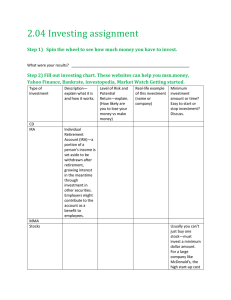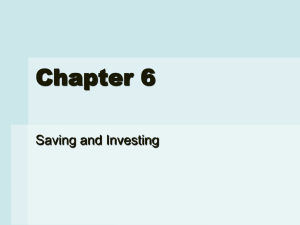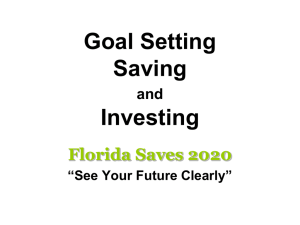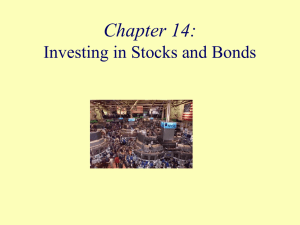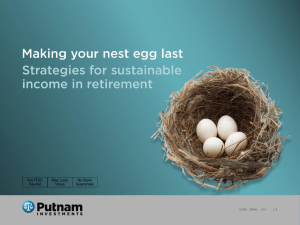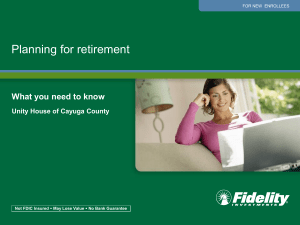File
advertisement
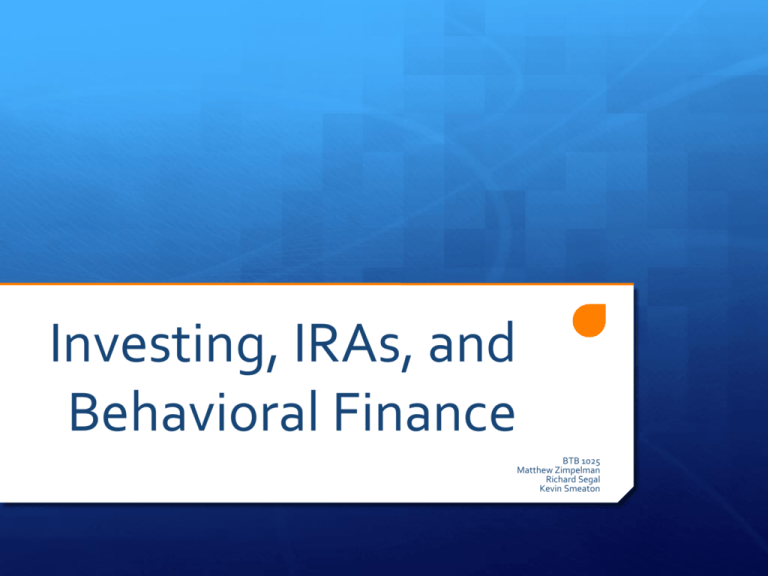
Investing, IRAs, and Behavioral Finance BTB 1025 Matthew Zimpelman Richard Segal Kevin Smeaton Why Invest? https://www.youtube.com/watch?v=tp6n8ChUPZA Understand your risk tolerance Understanding Bonds How Bonds Work Coupon Rate vs. Interest Rate Receive invested amount at end of duration Types of Bonds Treasury (Government) Bonds: low risk, low return Municipal Bonds: tax-free interest Corporate Bonds: higher risk, higher return Important Factors when Choosing a Bond Pricing Discount Premium Par Value Duration Coupon Rate Depends on Risk Tolerance Understanding Stocks What are stocks? Ownership in a corporation Buy Low, Sell High Understand Return Dividends A distribution of a portion of a company's earnings, decided by the board of directors, to a class of its shareholders. Shorting Stocks = Betting against a company Sell High, Buy Low Example Average Return on Stock Market = 10-11% Long Term Investing Tips Diversification Investment types (Bonds vs. stocks vs. other investment types) Market type (Ex: automobile market) Be Patient Don’t track daily, weekly, monthly changes Some years you might lose money, don’t worry Invest Earlier = More Money = Retire Earlier! Long Term Investment Scenario http://www.daveramsey.com/article/how-teens-can- become-millionaires/lifeandmoney_kidsandmoney/ Who Wants to Be a Millionaire? If you took $1,000 and invested it, what would happen? If you waited for 50 years, you could be a millionaire!!!! (Or at very least a hundred-thousand-aire!)) How??? Compounding Interest and Smart Investing! What is compounding interest? Return Rates Historical Average Return on the Stock Market = 11% Aggressive Approach (Good Investing) = 15% Path to Becoming a Millionaire! Year Total Amount: Avg. Market Rate Return = 11% Total Amount: Aggressive Approach/ Return = 15% 0 $1,000.00 $1,000.00 1 $1,100.00 $1,150.00 2 $1,232,00 $1,322,50 10 $2,839.4 $4,045.56 20 $8,062.3 $16,366.54 35 $38,574.85 $133,175.52 50 $184,564.83 $1,083,657.44 Retirement Planning Save now in order to retire at younger age Money growth is exponential Different forms of retirement accounts: Benefit Plans (employer sponsored) Traditional IRAs Roth IRAs IRA—individual retirement account Personal account that works similar to benefit plan Benefit Plans Most common is a 401k plan Contributions made by employee into the firm’s plan Sometimes employer will match your contributions up to a certain amount If possible, ALWAYS contribute the MAXIMUM that the employer will match Earnings are tax deferred Major benefit due to compound interest 403b plan (non-profit organizations 457b plan (governmental employers) Traditional IRA Personal retirement account Each person allowed to contribute max $5,500 Age 50+, can contribute additional $1,000 as “catch up” Earnings are tax deferred until withdrawn Compound interest on larger sum of money Because it isn’t being taxed today Good if tax rate is lower when money is withdrawn Roth IRA Also a personal retirement account Max contribution is also $5,500 Age 50+, can contribute additional $1,000 as “catch up” Earnings are taxed when earned Do not pay taxes when withdraw funds Good if tax rate increases over time What is Behavioral Finance? “The area of finance dealing with the implications of investor reasoning errors on investment decisions and market prices” ● Reasoning Errors Occur by Investors ● Proponents of behavioral finance believe these errors cause market inefficiencies Introductory Activity We give you $4000. Next, you can take one of the following two options: A. You can have $1000 more dollars from us B. You can flip a coin. If it lands on heads, you get $2000 more from us. Tails, you get nothing. Introductory Activity 2 We give you $6000. Next, you can take one of the following two options: A. You can lose $1000 B. You can flip a coin. Heads, you lose $2000. Tails, you lose nothing Frame Dependence Both scenarios we went through were exactly the same. ● Option A: You would have ended up with $5000 ● Option B: 50% chance you would have ended up with $6000, and 50% chance of getting $4000 Therefore, you should chose the same answer in both scenarios. Why didn’t you? Loss Aversion ● Reluctance to selling investments after they fall in value ● Always evaluate stocks at their current price o Do not base on past prices ● Barings Bank and Nicholas Leeson ● Individual 1.5 times more likely to sell a gain then sell a loss Overconfidence ● Overconfidence leads to more trading o more trades leads to lower relative returns ● Overtrading is “a guy thing” o o men trade about 50% more than women men have riskier portfolios than women ● 43% of households outperform market o lack of diversification Misperceiving Randomness The Hot Hand Fallacy: Common misconception in sports: If player is doing well, he should continue to do well? Stats show that having “hot hand” does not increase chances of staying “hot” Coin flip activity You flip the coin one more time, do you think it will it be heads or tails? Overreacting to Chance ● The Gambler’s Fallacy: o The idea that if an event hasn’t happened recently it is “overdue” and is bound to happen soon ● These types of cognitive errors are called “forecasting errors” Works Cited The Motely Fool http://www.fool.com/teens/teens01.htm Jordan, Bradford, Thomas Miller, Jr., and Steven Dolvin. Fundamentals of Investments. 7th ed McGrawHill, 2015. Print. ("Hedge Fund Definition | Investopedia." Investopedia. N.p., n.d. Web. 23 Sept. 2014.)


